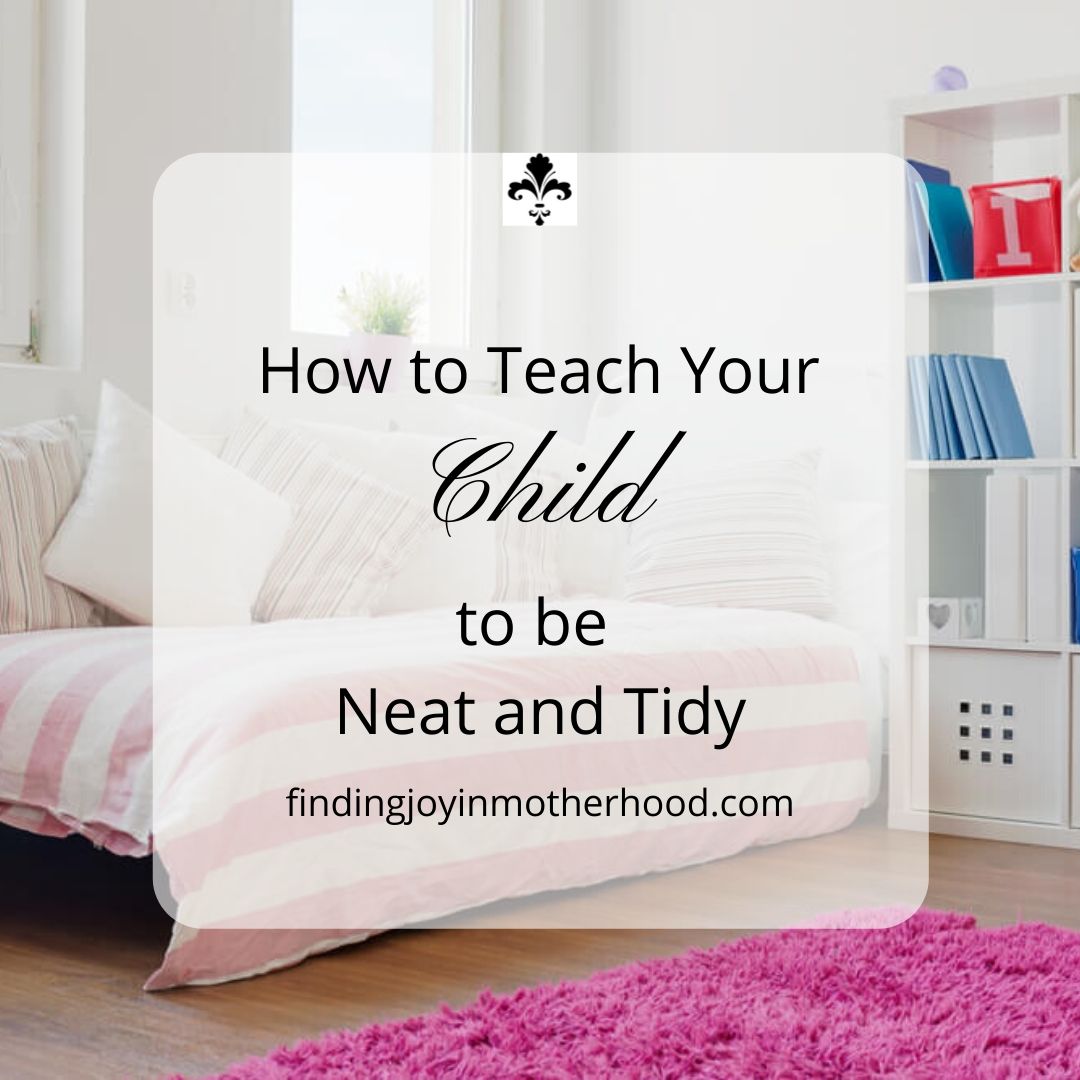I have good news for the overwhelmed moms who feel like they are constantly picking up and the only one responsible for keeping their homes tidy. Here’s how to teach your child to be neat and tidy from a very young age that will not only enhance the peace and tranquility of the home, but will also create an orderly adult in the process. Neat, orderly, and organized adults rarely ‘just happen’.
Many have agreed that the state of our place (home, bedroom, closet) is the state of our mind. Do you find that to be true for yourself? Is your home neat, clean, and orderly contributing to a calm peace of mind, or is your home a cluttered mess, and upon reflection you find your mind to be cluttered and stressed? Likewise, if we help our children have order in their daily routines as well as in their environment, it will eliminate a lot of decision-making stress that they may otherwise have to push through.
Teaching children to be orderly is important for the outside physical things of their world, but by teaching them to order the physical items of their world, you are also teaching them to mentally order their life. Outside order contributes to interior order and logical thinking.
The Benefits of the Virtue of Orderliness (Neat, Tidy, Organized)
- Order contributes to the peace of the home.
- Peace of mind is a consequence of an orderly environment
- Maintaining order respects the others with whom we live.
- Teaching order to our children helps them participate in the shared responsibility of keeping the home neat and tidy.
- Teaching order helps children understand that there’s a place for everything, and everything should be in its place. When they go to look for something, rather than wasting time trying to find it, it should be in its place.
How Do You Teach Your Child to Be Neat and Tidy?
Set the Example –
Ok, first, don’t panic or feel like you’ll never be able to teach your children order because you struggle with order yourself. That said, there’s always room to up our game in the order department. Children don’t expect us to be perfect, so don’t worry that you have disorder in your home sometimes. If you are trying to create order, the children will see that and will know that it is a goal for the home.
Set Expectations –
So often we forget that children need to be taught skills, habits, routines. You’ll need to clearly articulate your expectations of how they keep their toys/clothes/room orderly by showing them, and helping them establish the routine. And you’ll need to show/help them many times.
Learning a virtue (a good habit) is like learning a new musical instrument. You have to practice every day before you get good at it.
Teach with Affection –
I’m convinced that when I taught in the schools, the children were receptive to me and performed well because I genuinely cared for them. Although I had to correct them sometimes, most of the time I was encouraging them, praising them and rewarding them for their efforts and a job well done.
Remember you are your children’s first teacher. We sometimes need to remind ourselves that we should be tender yet firm, kind while being demanding with our own children. Teaching with affection produces results so much faster and longer lasting than nagging and yelling.
Now, I’m not living in a bubble, and my kids at home will tell you that I lost my patience plenty of times as they were older, but nothing attracts like fun and encouragement – so encourage rather than complain or nag. And NO BRIBES! The reward should be a job well done, and maybe a surprise treat occasionally.
Teach by Doing Together-
I’ll never forget the day I asked my mom if I could help her empty the dishwasher. I couldn’t have been more than 8 and of course she was happy to show me how! It was a great way to demonstrate that 1. You had to do it carefully so that nothing was broken, and 2. Everything had a place.
Here are some ways you can work together with your small children to teach them order:
- Empty the dishwasher together
- Put away the utensils – they love to stack the forks with the forks, spoons, with spoons etc..make a game out of it
- Fold the washcloths
- Put away the laundry – socks, underwear
- Sort their toys with them into bins putting like things together.
Keeping it real – There were a few times when I told one or more of my 5 teenage sons that if they didn’t pick up and clean their room, I would throw everything in garbage bags and pitch. They knew I was serious.
One time, I did pick up everything and put it all into garbage bags. They had to do additional chores to get the items back – one by one. It was a great lesson!
Three Important Areas to Teach Your Children to be Neat and Tidy
Order in Habits
- Help them develop routines. Check out this post and the download for age appropriate routines and habits your child can and should do.
- Morning Routines – make bed immediately, breakfast, brush teeth, get dressed, put pjs away
- Middle of the Day Routines – pick up before lunch, nap time/quiet time
- Dinner Routines – everything picked up, set the table, don’t eat until mom sits down, everyone clears their plates and helps clean up.
- Nighttime Routines – pick up, get ready for bed, brush teeth, read for set time, prayers, bed with no getting up afterwards
- Room Cleaning Routines – Saturday cleaning day- change sheets (littles can do this!), dust, vacuum, throw away garbage, put everything in its place
Order in Possessions
- Have just what they need or play with and remove the rest. Don’t have too many things in their room or you set them up to fail. Too many things – whether it’s clothes, toys or both, overwhelm children. They’ll spend all their time cleaning up and organizing their things rather than using them properly.
- Be vigilant about decluttering toys. ONLY keep out what they actually play with. Store other toys and rotate them out. If you find they never play with a particular toy, give it away. Help grandparents by offering suggestions of toys you think they’ll enjoy for gifts. As a grandparent, I don’t want to waste my money. I’d rather buy something you think they’ll love than something I hope they’ll love. And in the end, if they don’t play with it, either keep it for other children or donate to a good cause.
- With 7 children, we were always on a tight budget. That was actually very helpful, because I only purchased what they really needed. No fashion prizes in our family, but they had clean clothes and not so many that they were a mess in their rooms.
- Clothes- 1 pr tennis shoes, 1 pr. church (dress) shoes, 2 church outfits, 2 prs. jeans, 2 prs. other play pants, 5 shirts, 1 sweatshirt, 1 spring/fall coat, 1 winter coat, 8-10 prs. underwear, 8 prs. socks -all the same style, 2 prs. pjs.
- Drawers/shelves designated for certain clothes. They should return to that drawer (i.e. underwear/sock drawer, pants drawer, shirts drawer or baskets in the closet)
- Every room has its own laundry basket.
Order in Time
- Help them finish activity when necessary.
- Give them 5-minute warnings for the next event and stick to it. Help the little ones clean up.
- Mealtimes in our home was 20 minutes except dinner which was as long as our family needed. If you didn’t finish in that time and spent your time talking or wasting time, a warning was given, then food was promptly taken away. I promise, they won’t starve.
- Encourage them be responsible with time
- Don’t let them start something new five minutes before dinner, or 10 minutes before bedtime.
- If a friend calls to play with them, but they already began a task that needed to be completed, help them say, “I can’t play right now”.
- Teach them from early on that just because they want to do something now, doesn’t mean they can or should.
- Homework schedule
- Let them have some run around time after school and snack, but have a clear time on the clock every day when they regroup and come back to do homework with enough time before dinner.
- School project schedule
- When they get older, teach them the habit of preparing in advance for deadlines. Don’t let them wait until the night before to begin a paper or project. Show them how to look at the calendar deadline, then back it up for the days needed to finish the project two days before the deadline. There will always be last minute adjustments and that couple of days leeway will give you the time needed.
Teach Your Child to Be Neat and Tidy
So many moms are overwhelmed with the care and order of their home. A big part of the problem is that we have too much stuff making it hard to keep order. Check this post on how to declutter. But in addition, we as moms, have taken on the full responsibility to keep the home clean.
Everyone, from our husbands down to the smallest walking child, can and should participate in keeping the home neat and orderly. It’s a matter of justice that everyone feels that responsibility, and it also helps our children develop a sound sense of order – creating a firm foundation upon which many other virtues can be developed.
Have a great week!
Janet





No Comments